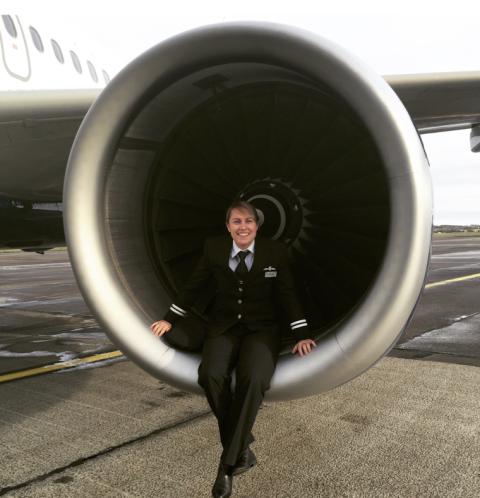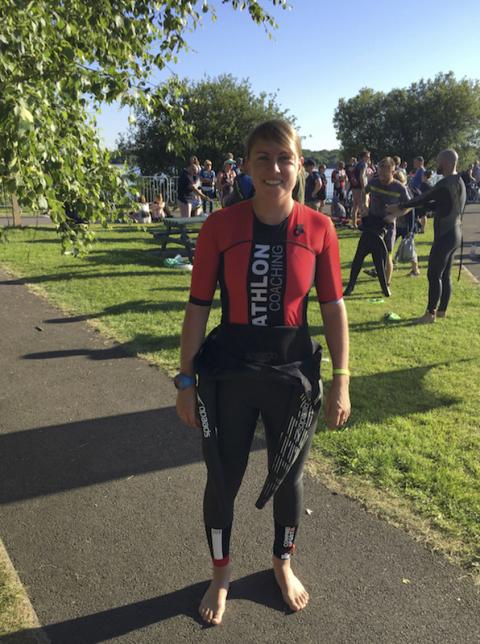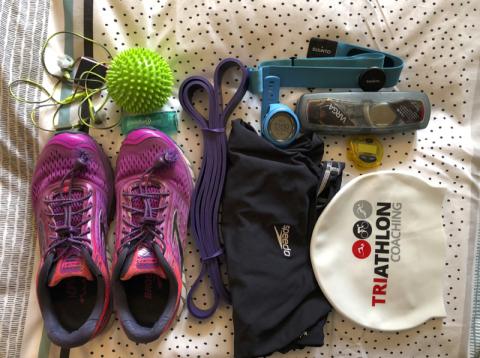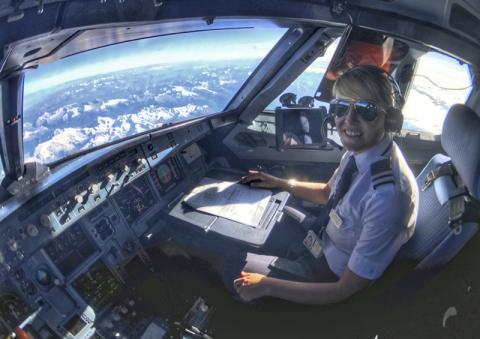Fly, Train, Sleep, Repeat!
29th May 2018 - 19:23 ">
Most of us have to juggle our weekly training sessions around work. Trying to complete all your sessions AND not letting down your boss can be a tricky enough task if you're based in just one location, let alone several different cities in the space of a week. One #TeamTCUK athlete, Hannah Vaughan, has become somewhat of an expert 'training session juggler' over the last few years flying people around Europe and beyond in her career as a pilot with British Airways!

My alarm’s going off and I find the snooze button for the umpteenth time. The usual questions start running through my head. What time is it? Where am I? What time’s my wake up call? What time does breakfast finish? What do I have to do today?
The middle three questions probably seem a bit unusual, but I can’t tell you how many times I’ve woken up in my own bed confused about which hotel I’m in and tried to ring down for room service! I guess if this were on Twitter or Instagram I’d say #pilotproblems.
As well as being a #TeamTCUK athlete, I’m a short haul pilot for British Airways. This means I spend most of my working life sat in the pointy end of a jet, whizzing around Europe and slightly further afield.

Unfortunately there’s no real structure to our rosters, and this means the same for my training programme, despite Matt’s best efforts and mine! Report times at work can be at anytime from 5am through to about 8pm, and I can be back in time for dinner, or away for five days at a time!
Once we’re at work, there are no real breaks either as scheduled time between our flights is often eaten up by delays. This means that all of our meals are eaten mid-flight, which can be quite a rush on a short flight!
When we do have night stops, we generally get about 12-16 hours before being picked up from the hotel the next day. It allows just enough time to explore the city, grab some food and obviously get some sleep. But with such a hectic training programme, I normally have to get at least one training session in too!
A big misconception in this job is that the autopilot does everything. But the best way to think of it is like cruise control in a car. A fantastic tool that makes things a little easier, but you still have to control it and tell it what to do. The take off cannot be done by an autopilot, and most landings are manually flown too. We will generally only let the plane autoland if it’s really foggy at an airport and we can’t see the runway.
This means that different stages of the flight have different workloads. The cruise is the “chilled” part, where we fly level and speak to different air traffic controllers, and generally just monitor the aircraft systems, thinking ahead to the next stage. The busiest sections of the flights are the departure and the approach/landing. This is the most draining part of the job, where you’re on high alert for maybe 45 minutes at a time and have a lot of different tasks to do to get the aircraft in the air or on the ground safely and hopefully on time.
With your alertness going up and down as much as the plane, after three flights you are mentally tired. A 30ish minute drive to get from the airport to the hotel is a perfect amount of time to come down from that high and you feel shattered.
This is exactly what happened to me last week having reported at Heathrow at 5am. To get there in time my alarm went off at 3.30am (oh the glamour!). After being up 11 hours and having done three flights we ended the day in Geneva for the night.
When we got to the hotel I had most certainly come down from the high of the approach and with only 13 hours until pick-up, the last thing I wanted to do was go out for my 7-mile run. I’d have much rather had a nap, got my uniform ready for the next morning and met the Captain for some dinner. My brain’s very good at trying to work out how I can move my impending session to a different day later in the week, I have to be really strict, not sit down once I get to my hotel room and get out and train before I change my mind.
As it happened it turned out to be an absolutely fantastic run, the sun was shining and I had some amazing views of the snow-covered mountains as I ran round Lake Geneva. I got back to the hotel with so much more energy (how?!), quickly got showered and ready and was only a tiny bit late to meet the Captain to go and grab some food and a cheeky beer!
The next day we did it all again, flying the first flight out of Geneva, swapping planes at Heathrow and flying off to Istanbul this time for the night. This afternoon’s session was to be a swim as luckily the hotel there has a swimming pool. But rather than motivation being the issue today, it was a time restriction. I’d completely forgotten that Istanbul is three hours ahead of the UK, so by the time we got to the hotel it was 6pm local time. I had just enough time to get 1600m in before the fitness centre in the hotel closed, and an annoyed Turkish man asked me to get out of the pool and leave!
Just from an example of two days you can see how the travelling and time difference can make it slightly more challenging to get all the essential training in, but over the last three years I’ve slowly found a way to overcome these different obstacles and make it work.
Early starts– they’re never fun, but an early start usually means an early(ish) finish for the working day, so I can get training in during the afternoon. Or if I’m on lates, I’ll get up early and get a session in before our report time. All I have to do is just ignore my lazy brain and get the session done! This does help though on race mornings, when you have to get up and eat breakfast at 4am. My body clock is so used to being all over the place now that I think nothing of it…result!
Small suitcase – As crew our luggage allowance is the same as a passenger with “hand luggage only”. I have a cabin sized suitcase to fit all my kit and clothes in for potentially up to a five day trip. Sometimes it can be quite a struggle and I can be found sitting on my case to close it!
I generally find that on any typical night stop, whether it’s for one night or four, I have some essentials that are always in my case. This includes my running trainers, heart rate monitor, compeed, iPod, a spiky massage ball (to get some foam rolling done), resistance bands (for assisted pull ups or swim warm up), swimming costume, goggles, tempo trainer and swim hat.
With these things always in my case it means that whatever the gym facilities are like at the hotel, I can always get some sort of training done.

Dodgy gyms - I usually go in to a trip with the attitude that “you can run anywhere”, and if the hotel gym is really dire I can resort to doing a body weight S&C session in my room.
As I get more familiar with the places we stay I can plan my week of training a lot better around my work schedule. I know that I can usually get a swim session done in Beirut, Istanbul or Aberdeen, and the gym in Glasgow has decent spin bikes so I’d be able to do a session there to heart rate. But apart from that I plan to run or do S&C whilst I’m away and swim and cycle when I’m back at home. Sometimes this can be quite difficult to do, especially if I have a five-day trip, but a run heavy week isn’t too bad every so often!
Nutrition - One thing that I’ve really had to improve on doing the training alongside the job is my nutrition and hydration. Too often I’ve found myself feeling dehydrated as soon as I start a session after work, which when you spend 9 hours in a very dry environment is no real surprise.
The crew meals we get onboard are tiny. In my first year doing this job I was trying to be good, save money and eat just the meals provided by the company. After many sessions where I’d almost faint I started looking into the meal information. The most calorific lunch was less than 500 calories. There’s no surprise I was feeling faint, I can’t get down route and do a 10 mile run on that!
This is one reason I’m often seen running into Pret A Manger in the terminal to grab a sandwich, or drinking water like it’s going out of fashion. My bag is normally stocked with snacks too, but I try to keep them healthy(ish), so Meridian nut bars or protein bars are great as it stops me eating biscuits on board. I do this pretty much every time I go to work, just to give myself the best possible chance of getting a decent session in wherever I end up.

Muscle Imbalance - As most athletes know sitting down a lot can be a real issue in terms of muscle imbalance. I’ve struggled quite a lot with weak glutes and very tight hip flexors. I have definitely seen the importance of foam rolling and the glute activation/stabilisation in S&C sessions. I also make sure that I stand up at least once per flight and maybe do a few single leg squats behind my seat!
One thing I’ve found related to the job is shoulder impingement. It started when I was in training, when I’d usually fly in the left hand seat, and so most of the switches or buttons would be pressed with my right hand. This lead me to develop impingement in my right shoulder. It got so bad at one point, I found myself at A&E one evening adamant that I had done something more serious as I couldn’t even lift my arm to tie my hair up!
Now that I sit in the right hand seat of the Airbus, and use my left arm for pressing switches, I’ve seen my right shoulder get better, but my left shoulder get worse! Luckily it hasn’t got quite so bad yet that I can’t brush my hair. Although I haven’t found the cure yet, I do know that foam rolling and sports massage definitely helps.
I’m probably starting to sound like I’m complaining about my job now, but I promise I’m not, I absolutely love it!! Although it does create some challenges with my training the lifestyle is pretty fun. It still baffles me some days that I’ve woken up in my own bed in London, but then just 12 hours later I can be in Milan eating pizza and drinking prosecco, or Barcelona eating some paella in the sun.
Along with that it’s also given me some fantastic opportunities for my run sessions. When we have very little time, but I want to explore a city, a run becomes a great chance to get my training in and have a look around. The best I’ve found so far are the Park Run in Paris, selfie stick avoidance around the Colosseum in Rome, or jogging down the Danube to the very springy running track on Margaret Island in Budapest. My Strava is starting to look like a mini tour of Europe!!
As well as being an athlete, in the past year or so I have completed the Ironman Coaching Certification. Not only has this taught me a lot about how to coach an athlete, but also given me a lot more knowledge about how to build a training programme and therefore how to move my sessions around within the week.
Hopefully this means that in the near future I will be able to start coaching some #TeamTCUK athletes, which I’m very excited about!
Again this will bring with it a few more challenges in terms of where will I be on a Sunday to update athlete’s programmes or how will people contact me whilst I’m away? But with some prior planning, a laptop/iPad, Wifi and the xhale platform, I can update programmes or contact athletes from anywhere! I literally do mean anywhere and at anytime. Don’t get worried if you get messages from me at stupid o’clock in the morning, I’ll just be making the most of my time in a taxi to the airport!!
I think that’s enough rambling from me now, but I hope it’s been a good insight into the job of a pilot and how I work the training around it. And if you have any more questions about it, then please do get in contact. But most importantly if you fly with BA and hear me speaking over the tannoy, make sure you come and say hello!!